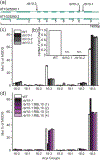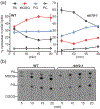A predicted plastid rhomboid protease affects phosphatidic acid metabolism in Arabidopsis thaliana
- PMID: 31062431
- PMCID: PMC6711814
- DOI: 10.1111/tpj.14377
A predicted plastid rhomboid protease affects phosphatidic acid metabolism in Arabidopsis thaliana
Abstract
The thylakoid membranes of the chloroplast harbor the photosynthetic machinery that converts light into chemical energy. Chloroplast membranes are unique in their lipid makeup, which is dominated by the galactolipids mono- and digalactosyldiacylglycerol (MGDG and DGDG). The most abundant galactolipid, MGDG, is assembled through both plastid and endoplasmic reticulum (ER) pathways in Arabidopsis, resulting in distinguishable molecular lipid species. Phosphatidic acid (PA) is the first glycerolipid formed by the plastid galactolipid biosynthetic pathway. It is converted to substrate diacylglycerol (DAG) for MGDG Synthase (MGD1) which adds to it a galactose from UDP-Gal. The enzymatic reactions yielding these galactolipids have been well established. However, auxiliary or regulatory factors are largely unknown. We identified a predicted rhomboid-like protease 10 (RBL10), located in plastids of Arabidopsis thaliana, that affects galactolipid biosynthesis likely through intramembrane proteolysis. Plants with T-DNA disruptions in RBL10 have greatly decreased 16:3 (acyl carbons:double bonds) and increased 18:3 acyl chain abundance in MGDG of leaves. Additionally, rbl10-1 mutants show reduced [14 C]-acetate incorporation into MGDG during pulse-chase labeling, indicating a reduced flux through the plastid galactolipid biosynthesis pathway. While plastid MGDG biosynthesis is blocked in rbl10-1 mutants, they are capable of synthesizing PA, as well as producing normal amounts of MGDG by compensating with ER-derived lipid precursors. These findings link this predicted protease to the utilization of PA for plastid galactolipid biosynthesis potentially revealing a regulatory mechanism in chloroplasts.
Keywords: chloroplast; enzyme biochemistry; galactolipid; lipid transport; membrane transport; phosphatidic acid; rhomboid protease.
© 2019 The Authors The Plant Journal © 2019 John Wiley & Sons Ltd.
Conflict of interest statement
Conflict of Interest
The authors declare that they do not have a financial conflict of interest.
Figures






References
-
- Alonso JM, Stepanova AN, Leisse TJ, Kim CJ, Chen H, Shinn P, Stevenson DK, Zimmerman J, Barajas P, Cheuk R, Gadrinab C, Heller C, Jeske A, Koesema E, Meyers CC, Parker H, Prednis L, Ansari Y, Choy N, Deen H, Geralt M, Hazari N, Hom E, Karnes M, Mulholland C, Ndubaku R, Schmidt I, Guzman P, Aguilar-Henonin L, Schmid M, Weigel D, Carter DE, Marchand T, Risseeuw E, Brogden D, Zeko A, Crosby WL, Berry CC and Ecker JR (2003) Genome-wide insertional mutagenesis of Arabidopsis thaliana. Science, 301, 653–657. - PubMed
-
- Awai K, Marechal E, Block MA, Brun D, Masuda T, Shimada H, Takamiya K, Ohta H and Joyard J (2001) Two types of MGDG synthase genes, found widely in both 16:3 and 18:3 plants, differentially mediate galactolipid syntheses in photosynthetic and nonphotosynthetic tissues in Arabidopsis thaliana. Proc Natl Acad Sci U S A, 98, 10960–10965. - PMC - PubMed
Publication types
MeSH terms
Substances
Grants and funding
LinkOut - more resources
Full Text Sources
Molecular Biology Databases

